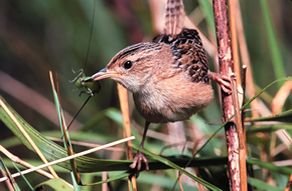Upper Midwest Environmental Sciences Center
Bird Use of and Productivity in Reed Canary Grass Dominating Wet Meadows
Wet meadows are an endangered habitat because they occur as an ecotone between semipermanent wetlands and upland grasslands. Wetland and grassland losses over the last century have been severe. Grassland birds are undergoing more recent but widespread and significant population declines. Little is known about the importance of wet meadows for maintaining biodiversity and healthy plant and animal populations. |
 |
Furthermore, reed canary grass, though native, has become aggressive and invasive after interbreeding with introduced European strains.
It now dominates wet meadows in the Upper Midwest greatly lowering the vegetative diversity of many areas. Reed canary grass is difficult to control or eliminate.
Objectives of this research are as follows:
- to determine bird species composition, diversity, and abundance in wet meadows on U.S. Fish and Wildlife Service refuge lands that are dominated by native plants or Phalaris;
- to determine habitat variables (e.g., vegetation structure and floristics, food resources, landscape setting) related to the bird community; and
- to evaluate effects of habitat management by U.S. Fish and Wildlife Service refuges in the Upper Midwest on reed canary grass and the grassland bird communities in wet meadows.
Bird and vegetation surveys are being conducted in wet meadows and grasslands with varying degrees of reed canary grass dominance and under different habitat management regimes. Results of this study will provide useful information to land managers concerning the effects of habitat management on reed canary grass. Information will also be provided on how grassland birds are affected by habitat management, vegetation diversity, and landscape features adjacent to wet meadows on grassland birds.
Study areas are in six different riverine systems in southeast Minnesota and southwest Wisconsin (Driftless area).
This project began in April 2001 and was completed in September 2004.
Breeding bird territory placement in riparian wet meadows in relation to invasive reed canary grass, Phalaris arundinacea (Abstract)
Principal Investigator: Eileen Kirsch
URL: http://umesc.usgs.gov/terrestrial/migratory_birds/ekirsch_5003547.htmlPage Contact Information: Contacting the Upper Midwest Environmental Sciences Center
Page Last Modified: January 3, 2011



